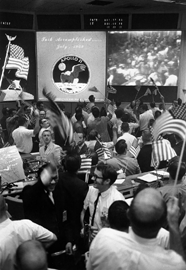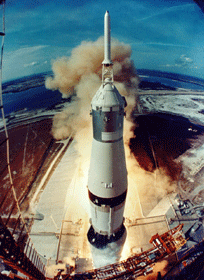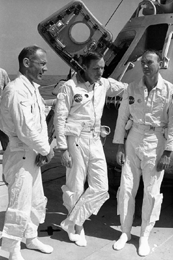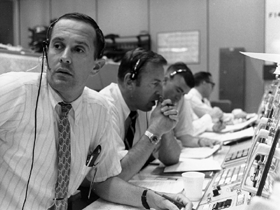If We Can Put a Man on the Moon
Air Date: Week of July 17, 2009

Houston celebrates the successful moon mission, a moment nine years in the making.
For the past 40 years we have been using the moon landing as our gold standard for measuring every one-of-a-kind challenge humans face. Most recently environmentalists have stacked the lunar voyage alongside the crusade against global warming. Host Jeff Young asks NASA’s chief historian, Steve Dick, how this metaphor works and how it fails.
Transcript
YOUNG: Of course there have been moments when American science took us all to new heights.

A launch tower camera captures blastoff.(Courtesy of NASA)
[ROCKET SOUNDS]
YOUNG: They were young men, mostly in their mid-twenties, working with the computing power of a calculator. But somehow they sent three astronauts nearly a quarter-million miles to the moon. And when the Eagle landed, even the crew at Mission Control could hardly believe it.
NASA: We copy you on the ground, you got a bunch of guys about to turn blue, we’re breathing again thanks a lot.
YOUNG: For 40 years now the Apollo mission has been the gold standard for measuring every other challenge facing us - if we can put a man on the moon, why can’t we end poverty or disease?
And most recently the moonshot metaphor’s been applied to global warming. There’s an Apollo Alliance for clean energy. And when former Vice President Al Gore issued his challenge for carbon free electricity he went straight to the words of John Kennedy and Neil Armstrong.
GORE: We must now lift our nation to reach another goal that will change history. Our success depends on our willingness as a people to undertake this journey and to complete it in ten years. Once again we have another opportunity to take a giant leap for humankind.

The Apollo 11 crew relaxes during training. (Courtesy of NASA)
We called on NASA’s Chief Historian, Steve Dick, to learn whether – metaphorically speaking - Apollo is really apt for climate change.
DICK: Well in some ways it is although of course there are many differences. With Apollo we had to - it was really a more defined goal whereas the global climate problem is more amorphous in the sense that we could build the Saturn Five and the Apollo Command Module and the Lunar Lander to go to the moon. But to take care of the global climate change on the earth is much more difficult to do, I think it’s more difficult to get your arms around, although there are of course technologies involved which can help with that.
YOUNG: So, if it is viewed primarily as an engineering kind of problem, then maybe this is the right way to think about it. But obviously with something like climate change, there’s more than just an engineering task at hand.
DICK: That’s right because the technology is one thing, but you may not be able to solve the problems of global climate change with technology alone. I think it’s a lot more amorphous. There would have to be many different technologies. Not one single technology that you focus on.
YOUNG: How have these tools that we’ve developed to understand other planets helped us better understand or own planet?
DICK: Well, certainly if you look at the solar system, the studies that we’ve done on planetary atmospheres, for example, take two of the nearest planets, Mars and Venus. Mars has an atmosphere of about 6 millibars, less than a hundredth of the Earth’s atmosphere, which means that over time Mars lost most of its atmosphere. And why did that happen? On the other hand, on Venus, you have a very dense atmosphere almost entirely carbon dioxide and the temperatures there are above 900 degrees Fahrenheit, and that’s because there’s a runaway greenhouse effect on Venus. So we can use what we learn about other planetary atmospheres to apply to our own Earth atmosphere.
YOUNG: And indeed, that’s inspired a great number of people to start looking more closely at our atmosphere and what’s going on with our atmosphere.
DICK: Uh-huh. That’s right. You can call it comparative planetology. It’s always better to have more than a sample of one.
[LAUGHING]
DICK: … when you’re talking about things on a global basis and the best way to do that is to send the spacecraft out there and study.
YOUNG: And I guess, you know, looking at Venus and Mars, here we are the happy medium in between and we’d like to keep it that way.
DICK: Exactly.
YOUNG: You know, for all of the positive impact and inspiration that came with the moon shot, I wonder if there was also a bit of a downside, though, in that it may have inflated our hubris. And somehow the moon mission gave us a false sense of confidence about could be accomplished through technology alone.
DICK: Well you might say that. And it’s true that technology cannot solve all the problems. And of course it’s not so much the technology as how, you know, what use humans make of that technology. So in the end it always comes down to how the technology is used and that’s a matter of public policy and, you know, in a democratic society it’s something that people should have input in through their elected representatives.
YOUNG: You know, when we look at some of the history of the politics during the buildup to the Apollo mission, it was not uniformly popular. There were a lot of folks in Congress, say, who said “Hey, I could spend that money elsewhere.” Why was it unpopular, and how did the administration overcome that and keep the focus on the mission?
DICK: Well, I think it goes back to the same old problem that we have so many problems on earth, and there’s no doubt that we do have them – had them then, and we still have them now – that that money should be used more wisely on the earth. But I think the way they kept focus back then was this geopolitical context.

The mood at mission control is tense during the lunar module’s descent. (Courtesy of NASA)
YOUNG: So, again, if people want to apply this analogy “Hey, if we can go to the moon, we can whip climate change.” Maybe the lesson is the public needs to perceive an enemy.
DICK: Well, and the enemy is the carbon emission and all the things that the humans are doing to the Earth’s atmosphere. I guess you could say that we’re in competition with what we’re doing to the atmosphere. Our better aspects for taking care of the Earth are competing with the aspects that are you know, polluting the Earth. So in that way, it is a kind of competition with ourselves, that’s right.
YOUNG: We’ve met the enemy and he’s us as Pogo said.
DICK: [Laughs] Exactly.
YOUNG: Steve Dick is chief historian of NASA. Thank you very much for your time, sir.
DICK: Good talking with you.
[MUSIC: DubXanne “Walking On The Moon” from King Size Dub Chapter 69 – 15 years of Dubspin (Echo Beach 2009)]
Links
NASA celebrates Apollo’s 40th anniversary
Many environmental groups take inspiration from Apollo’s achievements
Living on Earth wants to hear from you!
Living on Earth
62 Calef Highway, Suite 212
Lee, NH 03861
Telephone: 617-287-4121
E-mail: comments@loe.org
Newsletter [Click here]
Donate to Living on Earth!
Living on Earth is an independent media program and relies entirely on contributions from listeners and institutions supporting public service. Please donate now to preserve an independent environmental voice.
NewsletterLiving on Earth offers a weekly delivery of the show's rundown to your mailbox. Sign up for our newsletter today!
 Sailors For The Sea: Be the change you want to sea.
Sailors For The Sea: Be the change you want to sea.
 The Grantham Foundation for the Protection of the Environment: Committed to protecting and improving the health of the global environment.
The Grantham Foundation for the Protection of the Environment: Committed to protecting and improving the health of the global environment.
 Contribute to Living on Earth and receive, as our gift to you, an archival print of one of Mark Seth Lender's extraordinary wildlife photographs. Follow the link to see Mark's current collection of photographs.
Contribute to Living on Earth and receive, as our gift to you, an archival print of one of Mark Seth Lender's extraordinary wildlife photographs. Follow the link to see Mark's current collection of photographs.
 Buy a signed copy of Mark Seth Lender's book Smeagull the Seagull & support Living on Earth
Buy a signed copy of Mark Seth Lender's book Smeagull the Seagull & support Living on Earth

